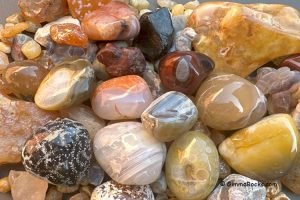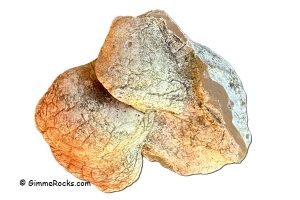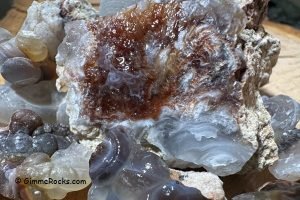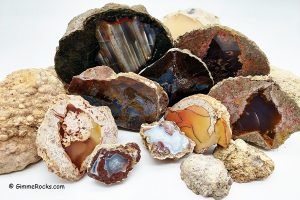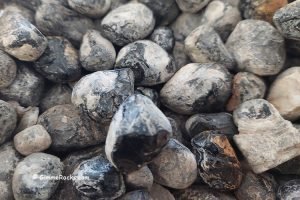Sagenite is not a mineral species or a scientific term but rather a descriptive label for net-like or radiating needle-like inclusions often embedded in host minerals such as quartz.
The term "sagenite" derives from the Greek word "sagene" (σαγήνη), meaning "net" or "fishnet."
While rutile (TiO₂) is the most common mineral associated with sagenitic patterns, other minerals can also form sagenitic inclusions. These include goethite, tourmaline, hematite, manganese, actinolite, epidote, and chlorite.
Agate, quartz, feldspar, amethyst, and occasionally calcite and fluorite are typical host rocks for sagenitic formations.
Sagenite formations are prized for their delicate, hair-like inclusions, which make them highly sought after by rockhounds and mineral collectors.
The term "Sagenite" comes from the Greek word "sagene" (σαγήνη), meaning "net" or "fishnet."
Sagenite Formation and Appearance
Formation
Sagenite forms when needle-like minerals develop during the early stages of agate formation. The needles are often concentrated in localized areas, creating intricate patterns. Over time, open spaces in the host mineral are filled with secondary minerals, typically chalcedony.
During the final stages of crystallization, the sagenitic needles may partially or entirely be dissolved, leaving delicate impressions behind.
Appearance
The host minerals containing sagenitic inclusions often exhibit a transparent or semi-transparent background, though they can sometimes be opaque. These backgrounds vary in color, showcasing a range of hues depending on the host mineral and lighting conditions.
Depending on the mineral composition and lighting conditions, Sagenite needles can appear in various colors, including golden, reddish-brown, black, silver, and sometimes green.
The most prized specimens feature clear, uninterrupted backgrounds where the sagenitic needles appear to float freely.
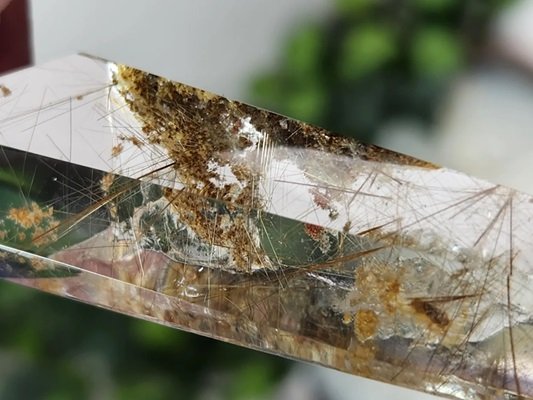
Sagenite Occurences
Sagenite is found in several locations worldwide, often in volcanic regions rich in quartz or metamorphic rock deposits. Notable locations include in the United States:
The United States of America
- California: Sagenite agates are found in Los Angeles, San Bernandino, and Santa Barbara Counties.
- Nevada: Notable deposits occur in regions with quartz-rich formations, such as Elco and Humboldt Counties.
- New Mexico: Sagenitic chalcedony is occasionally found in Luna County.
- Oregon: Sagenitic agate is found in Tillamook and Owyhee Counties.
Other Notable Locations
- Mexico: Produces sagenitic agates with vibrant inclusions against richly colored chalcedony backgrounds.
- Brazil: Renowned for its high-quality sagenitic formations with striking colors and patterns.

Lapidary Use of Sagenite
Sagenitic crystals are highly collectible and frequently displayed in their natural form. They are often cut into cabochons, polished, and set into custom jewelry, such as rings, pendants, and earrings. Their durability and striking appearance make them ideal for creating unique, one-of-a-kind pieces.
Value of Sagenitic Crystals
The value of sagenitic crystals depends on several factors, such as the quality of inclusions and host mineral appearance, origin, size, and condition.
Well-defined, radiating, intricate, needle-like patterns with vibrant colors and translucent or clear backgrounds are more desirable.
Larger, polished specimens with well-preserved inclusions are worth more than smaller or rough pieces. Specimens free of cracks or fractures are more valuable.
With its vibrant colors and exceptional clarity, Sagenitic agate from Mexico is highly prized among collectors and lapidary artists.
Price Range
- Rough Sagenitic Agate: $5–$20 per pound, depending on quality and origin.
- Polished Cabochons: $20–$100+ per piece, depending on clarity, inclusion quality, and size.
- Collector Specimens: High-quality sagenitic agates with striking inclusions can sell for $100–$500 or more.
Metaphysical Properties of Sagenite Agate
Sagenite agate is often associated with April, as quartz is a traditional birthstone for that month, and the zodiac sign Sagittarius (November 22–December 21.
Sagenitic agate perfectly complements Sagittarius' adventurous and philosophical nature because of its awesome qualities—wisdom, strength, and protection.
The unique patterns in sagenitic agate inspire personal growth, clarity, and balance, aligning perfectly with Sagittarius' energetic and optimistic personality. People view sagenite crystals as little powerhouses that enhance clarity, protection, and spiritual growth.
Their incredible needle-like inclusions symbolize connection and balance, grounding emotions and fostering harmony. They also ignite creativity and intuition, inspiring anyone who works with them.
You May Also Like
Reference:

